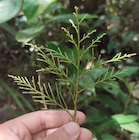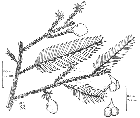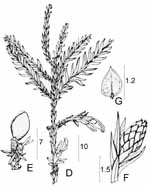Conservation Status

(all varieties)
Dacrycarpus imbricatus
(Blume) de Laub. (1969)
Common names
De Laubenfels (1988) and Van Royen (1979) lists a great many common names for this species; it seems to have a different name on every island and with every tribe within its range. For widely-spoken languages, names include 鸡毛松 jimao song [Chinese], Jamuju [Indonesian] and Thông lông gà [Vietnamese].
Taxonomic notes
Three varieties:
- Dacrycarpus imbricatus var. curvulus (Miq.) de Laub. (1969). Type not designated, but the basionym Podocarpus cupressinus var. curvulus was collected in Java by F. W. Junghuhn in about 1850.
- Dacrycarpus imbricatus var. imbricatus. Type: Indonesia, Java, C. L. Blume s.n. (lectotype L).
- Dacrycarpus imbricatus var. robustus de Laub. (1969). Type: Papua New Guinea, Eastern Highlands, Mt. Wilhelm, L. J. Brass 30568 (holotype A).
Synonymy: see POWO. The only synonym in recent literature is var. patula, described by de Laubenfels (1969) but reduced to synonymy with var. imbricatus by Farjon (2010) when he found matching specimens from throughout the range of the species, with both varieties sometimes on the same tree.
Molecular analysis by Khan et al. (2023) places Dacrycarpus imbricatus sister to the narrow endemic D. kinabaluensis. There do not seem to have been any detailed studies of infraspecific variation in this, the most widely-distributed species of Dacrycarpus.
Description
Shrubs, or trees up to 50 m tall and 200 cm dbh, usually with a single straight clear bole of up to 20 m and a open or dome-shaped crown of spreading, ascending branches (the lower ones often pendulous). Bark hard, rough, on large trees breaking into somewhat elongate plates or exfoliating in short strips, dark brown weathering dark to very pale gray; inner bark slightly fibrous, pink to reddish brown with brownish resin. Foliage dimorphic: short acicular and longer, imbricate scale-like leaves. Leaves on primary shoots, fertile shoots, and some terminal shoots (mature trees) spirally arranged, (sub-)acicular (thin and hair-like on seedlings), appressed to imbricate or spreading, incurved at tip, abaxially keeled, 1-4 × 0.4-1 mm. Most of the leaf biomass is on deciduous branchlets; these leaves are flattened, distichous, decurrent, slightly S-shaped, with parallel smooth margins, 7-12 × 1-2 mm, shortest at base and apex of twig. Stomata on all sides, in 1-2 longitudinal rows on acicular leaves and 3-6 rows on flattened leaves. Terminal shoots on young plants often elongated, whip-like, up to 20 cm. Pollen cones terminal on short shoots, subtended by small acicular leaves, 8-12 × 2-3 mm at maturity; microsporophylls 1.2 × 0.8 mm with a triangular, apiculate apex, each with two protruding pollen sacs. Seed cones terminal on short shoots, initially enclosed by spreading, 3-5 mm long acicular leaves which later subtend the receptacle. Mature receptacle 4-7 mm long, warty, orange-red or red with protruding green bract leaves. Seeds 1(-2) per receptacle, subglobose, 5-7 mm including a smooth glaucous-green to red-brown epimatium, with a longitudinally grooved crest and a curved, protruding apex (de Laubenfels 1988, FIPI 1996, Farjon 2010). See García Esteban et al. (2004) for a detailed characterization of the wood anatomy.
Var. curvulus is a shrub (sometimes procumbent) or tree to 8 m tall, with drooping to pendulous twigs. Adult imbricate scale leaves 1.2-3 × 0.8-1 mm; involucral leaves spreading, incurved, not exceeding the receptacle in length (Farjon 2010).
Var. imbricatus is a tree with leaves on primary shoots 1-2 × 0.4-0.6 mm, slightly spreading, free to imbricate, mostly appressed; shoots appear very slender (Farjon 2010). Sometimes the stem of full-grown trees produces sprouts at the base (de Laubenfels 1988).
Var. robustus has larger leaves on primary shoots, 2-6 × 0.6-1 mm, often nearly all spreading around the shoot; involucral leaves also spreading (Farjon 2010). Within the range of D. steupii, it can be distinguished from that species due to its smaller foliage leaves; also the involucral leaves are at least 5 mm long and curved upward (de Laubenfels 1988).
Speaking specifically of trees on the island of New Guinea, Van Royen (1979) presented this description: "Trees up to 33 m, bole up to 6 m and 100 cm across, crown spreading, consisting of stiff upright twigs. Bark black, brown or grey-brown, slightly to strongly, sometimes irregularly scaly, often flaking in horizontal thin strips, middle bark wine red, inner pink. Wood brown or white, or orangish straw coloured. Leaves midgreen or more or less glaucous, glabrous, bilaterally flattened and tetrastichous when young, sublinear, 10-17 by 1.2-2.2 mm, older leaves bifacially flattened, lanceolate, 2-4 by 0.7-1 mm, mucronate, rarely the older leaves bilaterally flattened and 3-5 by 0.6-0.8 mm, in older trees more or less scale-like, 1-1.8 mm long, not flattened nor tetrastichous, acute, crested on underside. Male strobili lateral or rarely terminal, on 1-3 mm long brachyblasts, at first ellipsoid, later cylindric, 6-12 by 2-2.5 mm, microsporophylls 2-4 mm long, at tip triangular, acute to apiculate. Female cones terminal, often on a brachyblast with elongate leaves below receptacle, these acicular, up to 4 mm long, needle-pointed, spreading. Receptacle glaucous, obovoid, 3-4 by 1-2.5 mm, warty. Fruits green with bluish tinge when ripe, ultimately red, (sub-)globose, 5-6 by 4-6 mm, more or less ribbed dorsally with a rounded crest."
Distribution and Ecology
Cambodia, China (Guangdong, Guangxi, Hainan, Yunnan), Fiji, Indonesia (Jawa, Lesser Sunda Is., Maluke Is., Papua, Sulawesi, Sumatera), Lao People’s Democratic Republic, Malaysia, N Myanmar, Papua New Guinea (Bismarck Archipelago), Philippines, Thailand, Vanuatu, Viet Nam (de Laubenfels 1988, Khan et al. 2023, Peng et al. 2023). It is recorded at elevations ranging from 122-3720 m, but is most commonly found at 1000-2000 m elevation (Farjon 2010). The highest recorded elevation is in New Guinea, and the lowest is near the coast in Fiji. Within its range, mean annual temperature is 18.0°C, with an average minimum in the coldest month of 11.7°C, and a mean annual precipitation of 2569 mm (Biffin et al. 2011, Table S5).
Distribution data (GBIF 2025). Collections without variety name shown in gray; var. curvulus in yellow, var. imbricatus in red, and var. robustus in blue.
Across its large range, D. imbricatus is a species of primary and secondary montane rainforest, typically as a codominant canopy or emergent tree. It occurs on silicic, carbonate, and ultramafic soils. Its most common association is Lithocarpus-Castanopsis mixed forest, often on steep slopes and ridges, but it is found in many different associations in different parts of its range (Farjon 2010). Examples include:
- In Viet Nam, it is sparsely distributed in Tuyen Quang, Son La, Lang Son, Hoa Binh, Ninh Binh, Quang Ninh, Nghe An, Ha Tinh, Quang Binh, especially in Na Hang (Tuyen Quang) and Ma river area (Son La), at altitudes between 300-1000 m, sometimes down to 200m (Quang Ninh). Usually mixed with broad-leaved species, such as: Celtis australis, Altingia siamensis, Cinnamomum spp., Gironniera subaequalis and Mallotus yunnanensis, growing sparsely along water courses. Light-demanding tree, but at young age shade-demanding, preferring humid, fertile soil, especially sandy soils, but also growing on clay-stony soil. Natural regeneration is strong (FIPI 1996).
- In W Jawa it occurs only on Mt. Tjeremai, along with Podocarpus neriifolius and Altingia noronhae, at 2400-2700 m elevation (Farjon 2010).
- In Malesia it is primarily in dipterocarp forests at elevations above 1200 m, associated with Lithocarpus, Castanopsis, and the conifers Agathis, Dacrydium, Phyllocladus, and Podocarpus (Farjon 2010).
- In New Guinea it occurs with Nothofagus and Phyllocladus hypophyllus (Farjon 2010).
Var. curvulus: N Sumatera (Atjeh: Leuser complex & G. Bandahara) and W Jawa (Priangan; Diëng). "In N. Sumatra forms pure stands on exposed mossy mountain peaks, on blangs and steep slopes, between 2000 and 3420 m" (de Laubenfels 1988).
Var. imbricatus occurs throughout the range of the species, as discussed above (Farjon 2010).
Var. robustus occurs on Borneo (Sarawak), in the Maluku Islands, (Morotal, Ceram) in the Philippines (Luzon, Mindanao), and on New Guinea (de Laubenfels 1988, Farjon 2010). In New Guinea it is "very common in primary and secondary rain-forest, as a canopy tree, or sometimes emergent, often co-dominant, in mossy forest associated with Nothofagus and Phyllocladus, also in Lithocarpus-Castanopsis mixed forest co-dominant, (500-)700-3000 m" (de Laubenfels 1988). Van Royen (1979) say that in New Guinea it is "A tree of the upper lowland zone to the subalpine regions, fairly common but scattered in the forest, in the subalpine shrubberies often emergent over the rest of the vegetation, 500-3720 m. Flowers the whole year round."
Zone 10 (cold hardiness limit between -1°C and +4.4°C) (Bannister and Neuner 2001).
Remarkable Specimens
No data as of 2023.02.21.
Ethnobotany
Widespread and common, this is one of the most valuable timber trees in southeast Asia. Its wood, usually called 'podocarp' or 'melur' in the trade, is not regarded as distinct from other podocarp woods. Its uses include furniture, cabinetry, woodcarving, paneling, veneer, boat masts, light construction, and pulp. It is also a moderately popular ornamental in tropical Asia and Oceania (Sosef 1995, Farjon 2010).
The wood is light (density 0.46-0.47), grain straight, fine, easy to work with, but not durable. Used for house-building, furniture and box-making (FIPI 1996).
Observations
A number of observations are reported on iNaturalist, and these are generally located in easily accessible locations. It is also widely reported from Mt. Kinabalu on Borneo, where it grows at up to 3400 m elevation and where one can also find Agathis kinabaluensis, Agathis lenticula, Dacrycarpus kinabaluensis, Dacrydium gibbsiae, Dacrydium gracile, Podocarpus gibbsiae, and Phyllocladus hypophyllus, all of which are endemic to northern Borneo and most of which are most easily seen at Kinabalu.
Remarks
The epithet is Latin, referring to the overlapping foliage found on primary shoots.
Citations
GBIF.org. 2025. GBIF Occurrence Download https://doi.org/10.15468/dl.2d7jw8, accessed 2025.02.21.
Khan, Raees, Robert S. Hill, Jie Liu, and Ed Biffin. 2023. Diversity, distribution, systematics and conservation status of Podocarpaceae. Plants 12(5):1171. https://doi.org/10.3390/plants12051171.
Laubenfels, D. J. de. 1969. A revision of the Malesian and Pacific rainforest conifers, I. Podocarpaceae, in part. Journal of the Arnold Arboretum 50:317-326. Available: Biodiversity Heritage Library, accessed 2021.12.24.
Peng, Y., Deng, F., Liu, L., Cui, C., Wang, Z., Li, N., Su, Y., and Wang, T. 2023. Lack of phylogeographic pattern in populations of Dacrycarpus imbricatus (Podocarpaceae) from mainland China and Hainan island. Pakistan Journal of Botany 55(1):171–184. https://doi.org/10.30848/PJB2023-1(20).
Sosef, M. S. M. 1995. Dacrycarpus imbricatus (Blume) de Laubenf. In: Lemmens, R.H.M.J., Soerianegara, I. and Wong, W.C. (Editors): Plant Resources of South-East Asia No 5(2): Timber trees; Minor commercial timbers. PROSEA Foundation, Bogor, Indonesia. https://prosea.prota4u.org/, accessed 2025.02.21.
See also
Hiep et al. 2004.
Luu and Thomas 2004 provide a description, range map, conservation status, drawings and photos, and a wealth of additional information.
McKone, Daniel. 1997. Dacrycarpus imbricatus. http://www.mckone.org/dac.html, accessed 2001.12.16, now defunct. This is a page devoted to D. imbricatus in Laos, containing many photographs.
Van Royen 1979.





